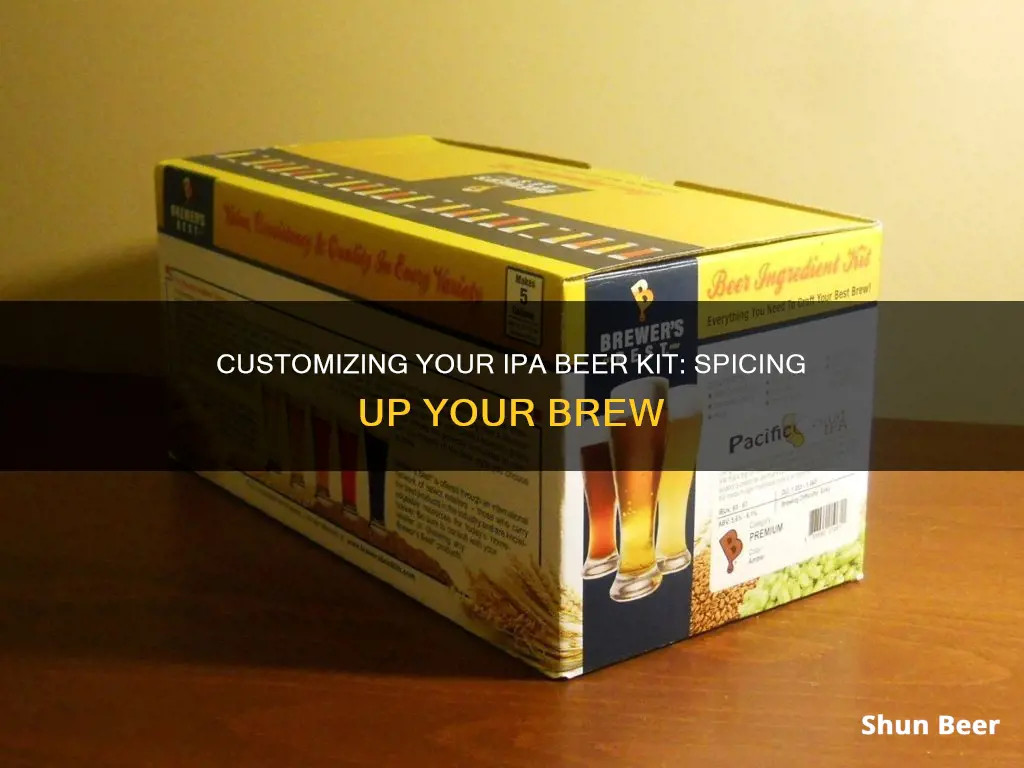
India Pale Ale (IPA) is a popular choice for home brewers, with its distinctive, hoppy taste. There are many IPA beer-making kits available, which provide the equipment and ingredients to brew your own IPA at home. However, if you want to spice up your DIY IPA beer kit, there are a few things you can do. Firstly, consider adding herbs and spices to your brew. These can be added during the boil or secondary fermentation, or even during bottling. Spices like cinnamon, ginger, nutmeg, and cloves can add warmth and sweetness, while chiles and black pepper can add a spicy kick. Just remember to use a delicate touch so as not to overwhelm the basic taste of your beer. Another way to spice up your IPA is to experiment with different types of hops. While Cascade, Simcoe, Amarillo, and Chinook hops are commonly used in IPAs, you can try blending different varieties to create unique flavour profiles. Finally, don't be afraid to get creative with your ingredients! Adding a few tablespoons of honey or fruit juice can give your IPA a unique twist.
What You'll Learn

Add herbs and spices
Adding herbs and spices to your IPA beer kit is a great way to experiment and personalise your brew. Here are some tips and tricks to help you spice up your DIY IPA beer kit:
Choosing Herbs and Spices
The type of herbs and spices you choose will depend on the flavour profile you want to create. Consider whether you want to add citrus notes, a spicy kick, or a hint of sweetness. You can use a single herb or spice or create a blend of several. Common herbs and spices used in beer brewing include:
- Cinnamon
- Cardamom
- Ginger
- Coriander
- Vanilla
- Chilli
- Basil
- Rosemary
- Lavender
- Chamomile
Amount of Herbs and Spices
It is important to use herbs and spices sparingly to avoid overwhelming the other flavours in your beer. As a general rule, calculate the amount you think you need and then halve it. You can always add more to subsequent batches if the flavour is too subtle.
Preparing Herbs and Spices
To get the best flavour from your herbs and spices, it is recommended to use fresh, whole versions. If using dried herbs, ensure they are not too old as they can lose their flavour and strength over time. Spices should be crushed, ground, or powdered to release their flavours. A spice grinder or mortar and pestle can be used for this purpose. The finer you grind your spices, the harder they will be to filter out, so keep this in mind if you want a clear brew.
When to Add Herbs and Spices
You can add herbs and spices at different stages of the brewing process depending on the results you want to achieve. Adding them during the last five minutes of the hop boil will give a softer, more mellow flavour. If you want a brighter, fresher flavour, add them during the secondary fermentation. For delicate herbs like basil or cilantro, add them in the last few minutes or at the end of the boil, as they impart their flavours quickly. Harder spices like cinnamon and black pepper require more boiling time to extract their flavours.
Sanitising Herbs and Spices
When adding herbs and spices to the secondary fermentation, they should be sanitised to prevent infection. This can be done by covering them in vodka or another grain alcohol. The alcohol will also help to extract some flavour from the spices.
By following these tips, you can spice up your DIY IPA beer kit and create a unique and flavourful brew!
Weight Watchers and Beer: How Many Points in an IPA?
You may want to see also

Use the right hops
Hops are an essential ingredient in any IPA, and choosing the right ones can make or break your beer. Here are some tips on how to select and use hops to spice up your DIY IPA beer kit:
- Choose the right variety: Different hops varieties will impart unique flavours and aromas to your beer. For bitterness, go for clean varieties such as Magnum, Nugget, or Galena. If you're aiming for a more intense bitter flavour, consider using hops extracts. For flavour, aroma, and dry hopping, popular options include Apollo, Bravo, Calypso, Citra, El Dorado, Mosaic, Simcoe, and Sorachi Ace.
- Timing is key: When you add the hops to your brew can significantly impact the final product. For a generous helping of hop flavour and aroma without making your beer overly bitter, try hop bursting. This technique involves adding a large amount of hops during the final 15 minutes or so of the boil.
- Experiment with combinations: While a single variety of hops can create a delicious IPA, don't be afraid to experiment with different combinations. Try pairing Simcoe with Amarillo and Centennial, Chinook with Simcoe, Citra with Columbus, or Mosaic with just about anything. Blending hops varieties is an art that you can refine through trial and error.
- Consider freshness: Always opt for fresh, in-season hops to ensure the best flavour. Look for hops that have been harvested recently, as the oils that provide flavour and aroma can degrade over time. If you're brewing in the northern hemisphere, aim for hops harvested between August and September. Alternatively, you can synchronise your brewing with the southern hemisphere hop harvest, which takes place in February and March.
- Pay attention to quantity: As a general guideline, aim for 1.5 to 2 ounces of hops per gallon of beer. However, remember that you can always adjust this ratio to your taste preferences.
Sour Beer and IPA: A Match Made in Heaven?
You may want to see also

Choose the right yeast
Choosing the right yeast is crucial to making a great IPA. Yeast is what makes beer, and it can make or break your brew. The right yeast will bring together all the ingredients and lend your beer some balance.
There are two predominant yeasts used in brewing: Saccharomyces cerevisiae (ale yeast) and Saccharomyces pastorianus (lager yeast). Ale yeast works best at room temperature (18-22°C or 64-71°F) and produces the slightly fruity characteristics common in ales. Lager yeast, on the other hand, works at much lower temperatures (8-15°C or 46-59°F) and gives that clean, crisp taste of lagers.
When choosing a yeast, consider the style of beer you want to produce and the flavour contribution you want from your yeast. For an IPA, you'll typically want a yeast with a clean and rather neutral fermentation profile to let the hops shine. Some specific strains can also add fruity flavours, like esters, which can complement the fruity notes from the hops.
- Wyeast American Ale 1056: Very versatile with a clean, crisp flavour and low fruitiness.
- Wyeast British Ale 1098: Allows malt and hop character to dominate with a dry and crisp finish.
- Wyeast London Ale III 1318: Originates from a traditional London brewery with a wonderful malt and hop profile.
- White Labs California Ale WLP001: Famous for its clean flavours, balance, and versatility.
- Fermentis SafAle™ US-05: A medium attenuating, neutral strain, often referred to as a Chico Ale strain.
- Fermentis SafAle™ S-04: A highly flocculating strain with medium attenuation and some fruity notes.
Remember, while these are popular choices, feel free to experiment with different strains to find the perfect yeast for your IPA.
Crafting Guinness Beer: A Step-by-Step Guide to Brewing Perfection
You may want to see also

Get the water profile right
Water is 90-95% of your beer, so it's important to get the water profile right. The ideal water profile for an IPA is hotly debated by homebrewers, but there are some general rules of thumb to follow.
Firstly, you'll want to achieve the right pH level. The pH for most beer styles should be between 5.2 and 5.6, but for IPAs, it should be slightly lower, between 5.2 and 5.4. This is slightly more acidic and will help balance out the flavours of the IPA. You can measure the pH of your water using pH test strips, which are easy to find online.
Next, you'll want to consider the mineral content of your water. The optimal mineral content varies between different types of IPAs. Juicier, fruitier IPAs should have higher levels of chloride and lower levels of sulfate. More bitter, pinier IPAs should have lower levels of chloride and higher levels of sulfate. The mineral content of your water can be adjusted by adding minerals to your water.
If you want to have the most control over the mineral content of your water, it's best to start with distilled or reverse osmosis water, as this gives you a blank slate to work from. If you don't have access to these types of water, filtered tap water is the next best option.
You can find out the profile of your tap water by buying an at-home test kit, getting your town's water report, or hiring a professional to test your water.
Guinness Beer: Fattening or Healthy Drink?
You may want to see also

Bottle it
Bottling your IPA is a crucial step in the brewing process, and it's important to do it correctly to ensure your beer tastes great and has the right amount of carbonation. Here's a detailed guide on how to bottle your IPA:
- Prepare your sanitiser: Before you begin bottling, sanitation is key. Mix the remaining sanitiser packet with water, following the instructions on the packet, to create a sanitising solution. This will help ensure your bottles are clean and sterile, preventing any unwanted bacteria from affecting the taste of your beer.
- Rinse your bottles: Use clean water to thoroughly rinse the inside of each bottle. This initial rinse will remove any visible dirt or dust.
- Sanitise your bottles: Fill each bottle with some of your sanitising solution. Shake the bottle to ensure the entire interior is coated, then empty the solution out. Allow the bottles to drain upside down to ensure all excess sanitiser is removed.
- Prepare your priming sugar: In a separate container, dissolve 3 tablespoons of honey in half a cup of water. This mixture will be added to your beer before bottling to provide food for the yeast and create carbonation.
- Siphon your beer: Using the racking cane, carefully siphon your beer from the fermenter into a sanitised pot. Be gentle to avoid splashing and creating excess foam.
- Add priming sugar: Pour the honey-water mixture into the pot with your beer. Stir gently to combine, being careful not to introduce too much oxygen.
- Bottle your beer: Attach the tubing to the racking cane, following the instructions provided with your kit. Open the tubing clamp and carefully siphon the beer from the pot into each bottle, filling them to the desired level. Close the bottles tightly with caps or stoppers.
- Store your bottles: Once all your bottles are filled, store them in a dark, cool place for at least two weeks. This is when the magic happens—the beer will continue to ferment and develop carbonation.
- Chill and enjoy: After two weeks, your beer should be nicely carbonated and ready to drink. Chill the bottles in the fridge before serving. Pop open a bottle, pour, and savour the fruits of your labour!
Remember, sanitation is critical throughout the bottling process to ensure the quality and safety of your beer. Always follow the instructions provided with your specific IPA kit, as there may be slight variations in the bottling process. Happy brewing!
The Evolution of Guinness Beer: A Historical Perspective
You may want to see also
Frequently asked questions
Adding spices, herbs, and hops is a great way to spice up a DIY IPA beer kit. Spices like cinnamon, ginger, nutmeg, cloves, cardamom, and anise can add warmth and sweetness, while herbs like Thai basil, orange balsam thyme, cilantro, and pineapple sage can give a fruity, verdant kick. Using different combinations and amounts of these ingredients can help you create a unique and flavorful beer.
You can try adding a hint of pine or spruce to your beer, which can add a crisp freshness and elevate your brew. Another option is to use spicy flavors like habanero, jalapeño, or black pepper to give your beer a surprising kick. If you're feeling adventurous, you can even add a dash of hot sauce.
The timing of when you add your spices and herbs will depend on the desired aroma and flavor intensity. For stronger flavors, add them during the half-hour mark of the boil. If you're aiming for more delicate aromas, add them towards the end of the boil or even during the secondary fermentation.
It's important to use a delicate touch when adding spices and herbs to your beer. The goal is to enhance the basic taste without overwhelming it. As a general rule, start with a smaller amount than you think you need and adjust from there. Remember, you can always add more in your next batch if the flavors are too subtle.
In addition to spices and herbs, experimenting with different types of hops can also spice up your IPA. Try using a combination of hops varieties, such as Simcoe with Amarillo or Chinook with Citra, to create unique flavor profiles. You can also play around with the timing of hop additions, as adding them at different stages of the brewing process will impact the flavor and aroma.







